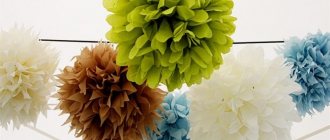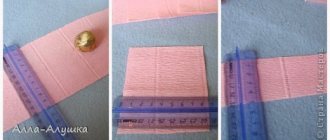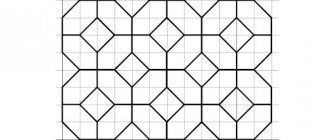Making a template
For handmade clothes, jewelry boxes, and toys, you need budget but original labels. They are made independently using the following materials:
- cardboard and paper;
- glue and brush;
- scissors;
- varnish and stain;
- set for fastening blocks.
The work takes place in one of the editors, for example, Microsoft Word. In a new document, you need to open the Inserts tab and select the appropriate shape, rotate it in the desired direction and set the size. Then text is inserted into the shape and adjusted by choosing a font and size. The tag must be double sided, so the first side is copied. It is better to change the text to the inscription “Handmade” or write good wishes to the buyer.
The labels are printed, the paper is covered with a layer of stain or shaded with tea, coffee, or food coloring. The tags must dry, after which they are cut out and pasted onto the cardboard, cutting it along the contours. Then the back of the business card is glued to the other side of the cardboard. They put pressure on it, otherwise the tag will curl in the corners. Even labels are covered with a layer of varnish on both sides , and blocks are attached to them. The finished product is hung on a ribbon from the item.
Self-production
So, to create your own clothing labels, you don’t need to be trained as a graphic designer. The procedure for creating a logo is very easy, because you will need minimal knowledge of any graphic editor and a bit of imagination.
Method 1
For further actions you will need the following items:
- Special thermal transfer paper for light-colored fabrics.
- A meter of light satin ribbon (width 1-2 cm).
- Laser or color printer.
- Fabric scissors.
- A small piece of fabric.
- Lighter.
Let's move on to the design development and further production of the label. In order to create tags for clothes with your own hands, you must follow the following algorithm:
- Draw your corporate logo in your favorite graphics editor. You can also seek the help of an experienced designer, download an image online, or slightly change someone else's label.
Important! There should be a minimum number of colors in your logo (maximum two).
- Once the logo is designed and drawn, it needs to be mirrored. This is necessary for convenient printing of tags on fabric.
- Create an A4 page and fill it completely with the labels you just created.
Important! Make sure there is enough free space between inserts.
- Print this sheet on thermal transfer paper, cut it into squares with logos.
- Move 1.5-2 cm from the edges of the satin ribbon and place the printed blank on it, then cover it with a piece of soft fabric prepared in advance and iron the structure with an iron without using steam.
Important! To see if the workpiece is imprinted on the tape, turn it over and see if the workpiece shows through. If yes, the image has been successfully reprinted.
- Next, you should remove the paper and run the iron over the ribbon again, turning it face down.
- Stepping back 1.5 cm from the tag, cut it off and heat the ends.
In the future, the finished label can be sewn or glued to the item you have made.
Method 2
If you don’t have special thermal transfer paper at your disposal, but you still really need a personalized piece of fabric, use the following method for making a clothing label with your own hands.
To do this you will need the following items:
- Silk ribbon 2-3 cm wide.
- Acetone or nail polish remover containing it.
- Fabric scissors.
- Matches or lighter.
- A piece of soft cloth.
- Iron.
- Ready-made reflected logos.
- Laser printer.
The manufacturing method is slightly different from the previous one. Here are brief instructions for making similar labels:
- Print the finished logos on a printer and cut them.
- Measure the desired length on the tape and copy its distance as many times as you have printed images.
- Cut the tape along the marked marks, burn the sections along the edges with a lighter so that it does not fray and ultimately looks neat.
- Attach the label printed on paper to the ribbon in the middle using a stationery clip.
Important! We recommend using black clips, because, unlike others, they do not fade when using aggressive agents.
- Pour acetone over the bonded materials. There is no need to feel sorry for it; the more it is poured, the better the end result will be.
Important! It is better to use this procedure on children’s oilcloth prepared in advance so as not to damage the furniture.
- Press the paper firmly against the tape with a napkin. When your logo is visible on the back of the tape, you can carefully remove the paper.
- Iron the tag on the reverse side. It is necessary to use the “for silk” mode.
Photo paper tag
Coffee-dyed photo paper will look impressive on toys and confectionery. Ready-made templates need to be printed on matte paper and cut out. First you need to prepare strong coffee. A cotton pad is soaked in the drink and squeezed over both sides of the label and dried. Then, using a toothbrush, apply small drops of coffee randomly across the paper, forming bright blots.
The paper is dried and placed under a heavy object to level it. Small rosebuds with leaves are printed separately. They are cut out and glued to one edge of the tags. Use a hole punch to make a hole in the top part of the business card and thread a rope into it, using which the tag is attached to the product.
Kraft paper in the product
Kraft paper tags do not require pre-made templates. You will need the following tools:
- figured hole punch;
- colored and kraft paper;
- glue;
- scissors, ruler;
- colored outline.
Rectangles are cut out of craft paper and holes are made in them using a shaped hole punch. Cutouts in the form of animals or flowers look impressive. The back side is cut out of colored paper, and shaped holes are also made on it. Both parts are glued and dried. Self-made labels are signed and a ribbon is threaded into the cutouts.
How to create a branded label
Depending on your skills and budget, there are two options.
Do it yourself
This method is free, but requires knowledge, time and effort. You will need skills in graphic editors such as Illustrator or Photoshop. Upload all the elements you want to place (logo, fonts, illustrations) and arrange them until you achieve the desired result.
Order from the designer
This option is suitable for those who have a development budget. A designer can be found on freelance exchanges, for example international (Upwork, Fiverr, People Per Hour) or local (in your country). Remember that the result will depend on the professionalism and style of the performer, so carefully study the reviews and portfolio before starting cooperation.
Cardboard at work
Beautiful tags for handmade products can be made from cardboard in combination with fabric, lace or felt. The paper must be matte, otherwise the textile parts will not stick to it. It is better to connect the workpieces with polymer glue or PVA.
The simplest tag is made of cardboard and cotton fabric. A pattern is drawn on the smooth side of the paper and labels of any shape are cut out. Flags, flowers or geometric shapes are cut out of cotton. They are glued onto cardboard and lines, branches or leaves are drawn in with markers. Wishes to the recipients are written at the bottom of the label, and satin or rope ropes are glued to the top.
In the editor you need to create templates in the form of vegetables and fruits, print them and cut out the parts from cardboard. Multi-colored blanks are made from felt along these same contours. The parts are connected using glue.
Beads are sewn onto the strawberries ; other tags can be decorated with glass beads and beads. Wishes are written on the back of the label. Tape is attached to the upper edges.
For a gift
Tags for hand-made products are not limited to clothing. This addition can also be used to decorate gifts. For example, you can decorate a bottle with a strong drink and thus congratulate a man on February 23 or on his birthday.
Related article: Master class on cross stitch with free pattern
We print out a suitable template on cardboard.
We put eyelets on them.
And attach it to the bottle.
A gift for the New Year could be this tag with origami Santa Claus.
You can also make tags from salt dough or self-hardening clay.
Imprint on the skin
Ceramic and wooden products need to be decorated with thicker labels. Tag templates for handmade products are made from paper. They are used to cut double-sided soft leather labels. The parts are glued together, and their edges are sewn with an overcast stitch. In handicraft stores you can buy a stamp with an inscription and make an imprint on a leather tag, but you can decorate it with beads and embroidery.
Business cards are also made from polymer clay or salt dough. They look impressive on a New Year's souvenir. Clay or dough is rolled out with a rolling pin, and figures are cut out using cookie cutters. An impression is made on the blanks and a hole is cut out. After drying, the edges are treated with sandpaper or sandpaper, and the labels are covered with acrylic paints. Clay tags are curved, but the dough product will remain flat.
Making a tag for your product by hand is not at all difficult. Thanks to the label, a handmade item acquires a marketable appearance. The buyer will understand that he has purchased a product made with love and care.
What types of labels are there?
Labels include barcode stickers, labels describing fabric care, and small brochures attached to packaging. Let's talk about the main criteria by which they are distinguished.
By size, shape and method of fastening
The choice of shapes and sizes is unlimited: they are determined by the size and features of the packaging, as well as your imagination (you don’t have to use a standard rectangle - think about a tag in the shape of the product).
Depending on the type of fastening, labels are divided into labels, tags and stickers. They can be sewn, glued or hung onto the product and used in different combinations. These nuances can be easily understood using clothing as an example:
- bright stickers on things indicate the size to make it easier to find on the shelf;
- the tag on the outside contains basic information (brand name, collection, sometimes slogan or barcode);
- The label sewn inside includes detailed information (manufacturer, article number, fabric composition, care features, etc.).
Source: Audrey Elise
Based on materials
Paper, cardboard, film, vinyl, textiles or even metal are an additional way to highlight a product. The choice of material depends on two factors:
- type of product and customer tastes: for example, fabric or craft paper is more suitable for handmade dolls, film is more suitable for juice bottles, and metal or leather is more suitable for premium stationery;
- storage and transportation method: if the product may become damp or wet, choose synthetic materials.
Source: Kirill Palii
By task
Depending on their use, labels, tags and stickers are divided into three types.
Identification
They are needed so as not to lose the goods during transportation or to quickly find them in the warehouse. As a rule, these are small stickers with the name of the batch, article number and barcode.
Information
Contains detailed information about the product: this type includes, for example, stickers on the back of beer or wine bottles. Please note that this information affects sales. According to statistics, 60 percent of people are unlikely to buy a product if there is not enough information on it, and 22 percent will choose a product that comes with a recipe or serving method.
Source: Elizabeth Tovkalo
Promotional
Their task is to attract customer attention and increase brand awareness. These could be bright red tags from the “Buy two, get the third free” series, scratch cards with an offer to take part in a drawing, or bright stickers with information about the benefits of the product.
90 percent of consumers say they are more likely to buy a product that has an instant savings coupon attached to it, and 59 percent say they would be attracted to a sticker with coupons or recipes.
Another good move is to take care of the benefits for customers, for example, develop stickers that allow the packaging to be resealed (like on handkerchiefs or snacks).











